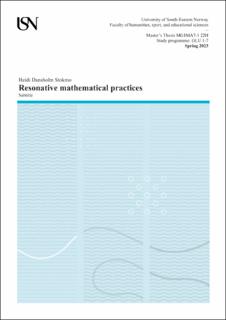Resonative Mathematical practices
Master thesis
Permanent lenke
https://hdl.handle.net/11250/3079957Utgivelsesdato
2023Metadata
Vis full innførselSamlinger
Sammendrag
This document presents the research findings of Heidi D. Stokmo´s master's thesis in mathematics education. The thesis explores how migration in mathematics is experienced through the lens of "resonance," which refers to the dynamic interplay between the individual and the collective during mathematical practices.
The thesis begins with an introduction to the concept of resonance and its relevance to the study of migration in mathematics education. The author argues that resonance can provide insight into the affective and embodied dimensions of mathematical practices, dimensions described by Gutiérrez & Rogoff (2003), and can help in better understanding the dynamic components of an individual’s cultural-historical repertoire.
The thesis is divided into chapters six, each of which explores a different aspect of resonance in mathematical practices. Chapter 1 and 2 provides an overview of the background and theoretical framework of this research. Chapter 3 described the research methodology, while Chapter 4 and 5 presents an analysis of how resonance manifests in students' engagement with mathematical tasks and focuses on the findings of this study which are patterns of resonance and dissonance encountered in the mathematics classroom as well as the dynamic interplay of the various components.
The first section of chapter 6 focuses on the role of the teacher in facilitating resonance during mathematical practices, while the second section explores the implications of resonance for mathematics education more broadly. The thesis concludes with a discussion of the potential contributions of resonance theory to mathematics education research and practice, specifically its ability to notice resonance in both familiar and unfamiliar mathematical practices.
Overall, the thesis argues that resonance provides a valuable framework for understanding the dynamic dimensions of cultural-historical repertories in mathematics learning and teaching, specifically when investigating the experience of migration in mathematics. The author suggests that future research in mathematics education should continue to explore the concept of resonance and its potential implications for understanding and promoting more engaging and effective mathematical practices in diverse classrooms.
